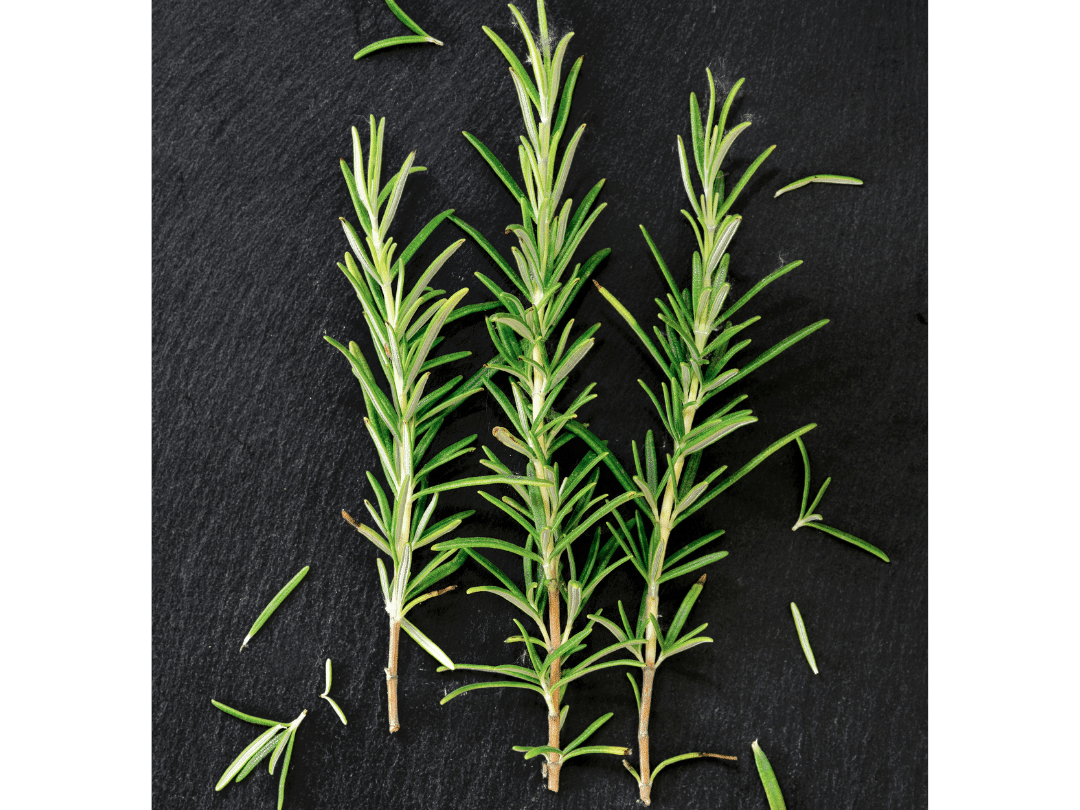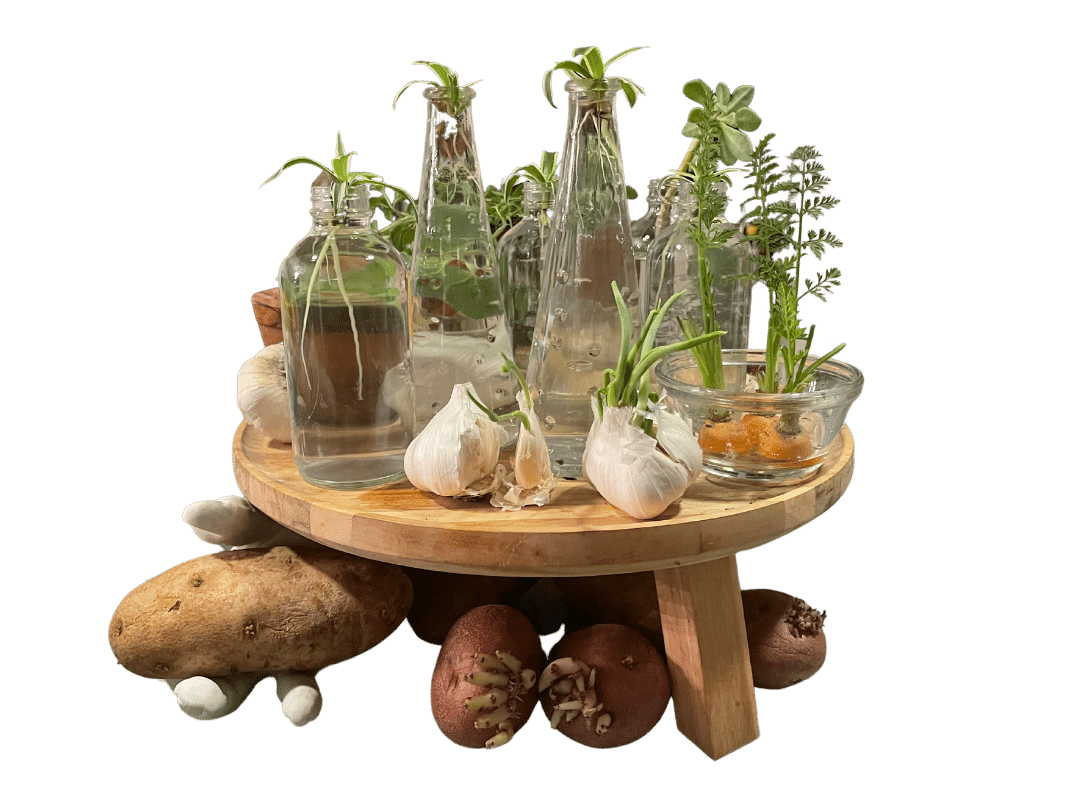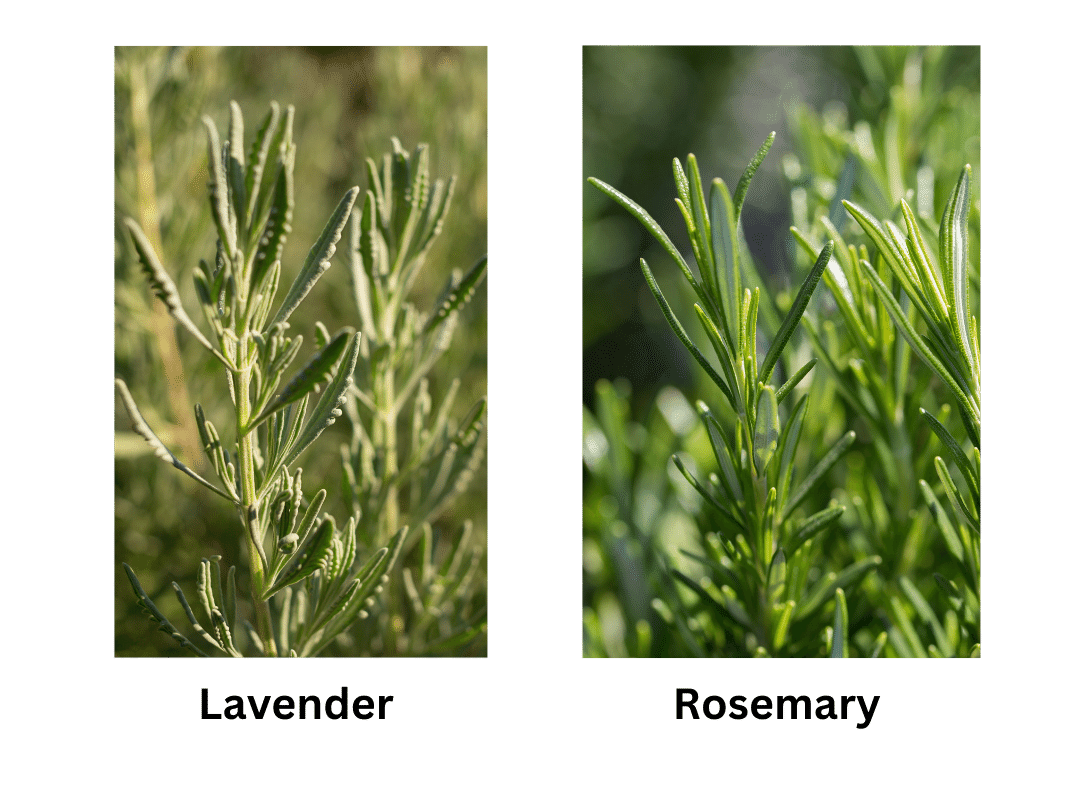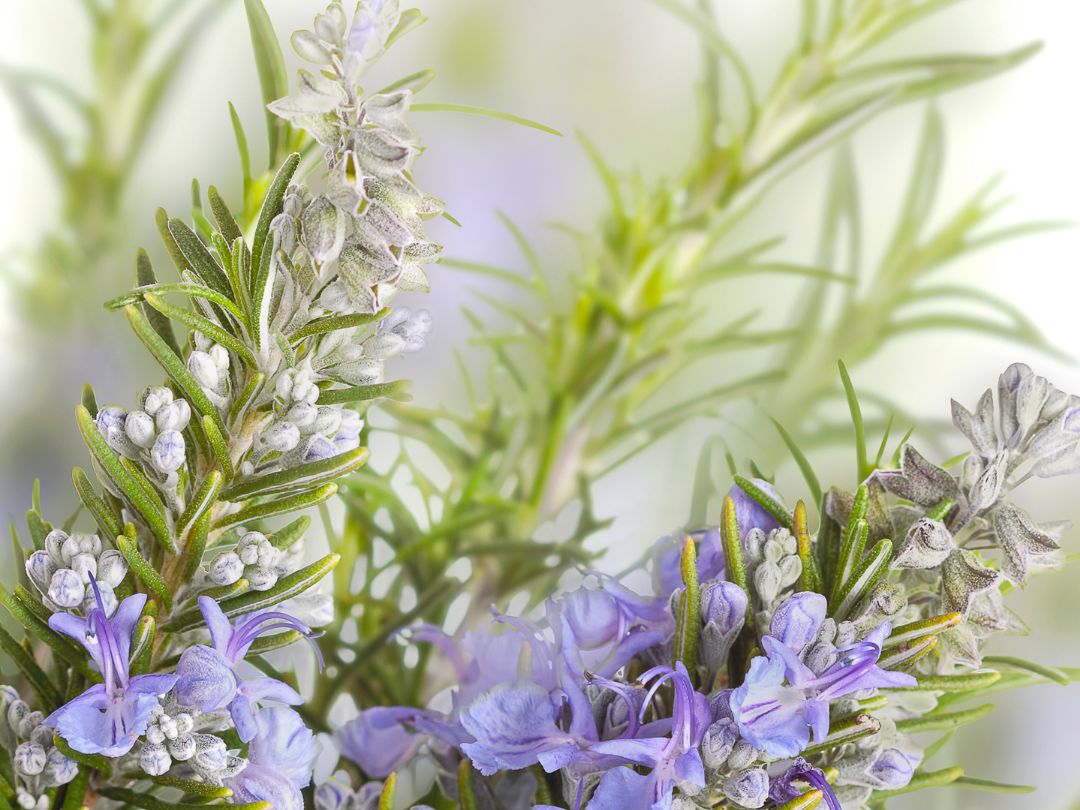Get to know rosemary! From upright rosemary to mounding varieties and ground covers—there’s so much I want to share.
I know there must be things I like more about living in a Mediterranean climate than my ability to grow rosemary, but it’s up there. Karen, my blog partner extraordinaire, isn’t as attached to this plant as I am, but I think I can convince her of its absolute wonder. Rosemary has been used in culinary and medicinal purposes for centuries. This plant truly has a long history, many uses, and deep benefits that we still utilize today.
With that in mind, I have embarked on an exhaustive ode to rosemary. Enjoy!
The Basics of Rosemary
Rosemary is a very attractive and water-wise evergreen shrub with scented pine needle-like leaves. The small and traditionally blue flowers dot the stems of the plant, lasting through spring and summer. In a warm climate like ours, (my blog partner and I live in Southern California), the plant can flower all year around. Native to the Mediterranean region, its botanical name, Rosmarinus officinalis, is derived from the old Latin for ‘dew of the sea’. This is in reference to the tiny pale blue dew-like flowers and the fact that rosemary was often grown near the sea.
Depending on the cultivar, rosemary will maintain a sprawling habit of 2 feet high or grow upright to 6 feet or even taller in the right conditions. Therefore, like most plants, you need to know your cultivar before you plant!
Rosemary is versatile in the garden! It tolerates dry, hot, humid and polluted environments. It puts up with garden pests, like deer and rabbits. And it grows in seashore, slope, and windy locations.
As you shall see, rosemary is also a gift in the garden.
Cultivation

I’ve never met a lay person who propagated rosemary. It is so easily available in a variety of sizes that it doesn’t really seem worth the time, but it isn’t hard to do.
If you start from a cutting, rosemary will be ready to plant in a few weeks. For the frugal gardener, what a gift it is to be able to easily produce many plants from one!
The 5 Easy Steps to Start a Rosemary Plant
1. Cut about 3-4” inches of rosemary off the top of a healthy stem. Spring or summer is the best time to do this when the plant is growing more actively. You will want to cut the greener part of the stem with the newer growth and avoid the tougher brown part of the stem just below.
2. Since you will be planting this, take off the lower portion, maybe about 1/3 of the leaves, leaving at least half of a dozen leaves on the cutting.
3. Dip the cut end of the stem in a rooting hormone. If you do not have any just keep going! This just helps speed things along.
4. Plant the cutting in a small container with a soilless potting mix and place in a sunny location. You will want to make sure to water before the soil dries out. You should also make sure the container has drainage holes. Excess water is the nemesis to the roots of rosemary.
5. In about three weeks roots will have developed. If you gently try to lift the new rosemary from the container and you feel resistance, the roots are in place and the plant is ready for transplanting to a sunny location.
You can also root the rosemary seedling in water, but it’s usually not as hardy when it comes time to transplant it. That said, if I have room on my countertop propagation station, I’ll rotate a piece of rosemary in. I enjoy watching the roots develop (and of course, the new plant, too). From cutting to planting it will take at least six weeks.

The photo above is my propagation station, a space on my kitchen island that gets enough light to start new plants. I started these Spider Plants a few weeks ago, and they are ready to plant.
Rosemary can be grown from seed if you’re in it for the long game (it does take a while for them to sprout). There is also the issue of not knowing exactly what you are going to get because the seeds often do not grow true to their parent plant.
Rosemary likes a well-drained soil and lots of sun. The thick shrub doesn’t mind being clipped, so the size can often be kept in check — but you don’t want to depend on this. It’s best to plant the right rosemary for the location because the plant will get woody over time, and trimming it back will start to expose the gnarly wooden underbelly. This is not a very attractive look.
You also want to make sure not to stress the rosemary by pruning too much of it all at once. Taking the plant back by more than a third can do this and make the plant susceptible to pests and diseases (more on that next). It is always best to think ahead and get the right variety of your rosemary plant.
Rosemary Pests and Diseases
Some common pests and diseases with rosemary plants include aphids spittlebug, thrips, mealybugs, scale, and root rot. With the bugs, I try to scrape them off and hose them off with water when I first notice them. I don’t troubleshoot with insecticidal soap or horticultural oil unless I have to. Some gardeners suggest spraying the plant with a hard spray of water once a week to avoid the buildup pests.
Root rot is basically the roots rotting due to fungus in the soil and overwatering. One way to avoid this is to use well-draining soil and not water the plant when the top of the soil is moist.
Rosemary is very low maintenance and performs well — as long as it’s not exposed to freezing temperatures.
Don’t Confuse Rosemary with Lavender

Some people get rosemary and lavender confused. Let me help you with that!
Run your hands along a branch of the plant and take a whiff. Lavender has a much more floral scent, while rosemary’s scent is woodsier. Some people say rosemary smells like a mixture of lemon, pine, and camphor. There is also a resinous quality to the oils on the leaves which will remain on your hands.
Take a closer look! The leaves of rosemary are green and very thin. They point upward off the plant. The flowers, which may be white, pink, blue or purple, will be clustered on the stem and within the leaves. The blooms of the lavender plant, on the other hand, will be at the top of the stem.
Rosemary does look good with lavender, though! Check out our Meerlo lavender blog to learn more.
Rosemary Forms and Varieties

Rosemary grows in different forms. There is ground cover, mounding, and upright rosemary. The varieties of rosemary don’t only differ in form, but also in their size and color of the leaves, as well as the color of their flowers. But, the aromatic pine-like needles remain a clear tell for this plant!
Here are ten rosemary varieties (listed from shortest to tallest.)
Ground Cover Rosemary
1. Huntington Carpet Rosemary
- Rosmarinus officinalis ‘Huntington Carpet’
- Height:1-2’
- Width: 4-8’
This is a great go-to ground cover rosemary that provides a green carpet with deep blue flowers. It is often used to soften and cascade down walls, or spread down a slope. It’s a good variety of rosemary to use for controlling erosion (another good reason to plant it on a hillside).
2. Dwarf/Prostrate Rosemary
- Rosmarinus officinalis ‘Prostratus’
- Height: 2-3’
- Width: 8’
This ground cover rosemary has pale blue flowers and is perfect for cascading down walls. It is also well suited for pots and containers.
Mounding Rosemary
3. Roman Beauty Rosemary
- Rosmarinus officinalis ‘Roman Beauty”
- Height: 2’
- Width: 2-3’
This is a lovely plant in the garden. It is both a mounding rosemary and a cascading spreader. It has violet-blue flowers and fragrant gray-green foliage.
4. Golden Rain
- Rosmarinus officinalis ‘Joyce DeBaggio’.
- Height: 3-4’
- Width: 3-4’
This mounding rosemary plant is also referred to as ‘Joyce DeBaggio’. It has yellow markings on its foliage and dark blue flowers. Its yellow-green leaves nicely contrast with darker greens.
Upright Rosemary
5. Majorica Pink Rosemary
- Rosmarinus officinalis ‘Majorica Pink’
- Height: 4’
- Wide: 2-4’
This upright rosemary plant has unusual pinkish-lavender blooms.
6. Blue Spires Rosemary
- Rosmarinus officinalis ‘Blue Spires’
- Height: 4-5’
- Wide: 2-3’
This is a very upright rosemary, giving it a more formal look. Its flowers are a clear blue.
7. Barbecue Rosemary
- Rosmarinus officinalis ‘Barbecue’
- Height: 4-6’
- Wide: 2-3’
Another upright rosemary variety, this plant is known for its beautiful blue blooms, as well as its excellent flavor and aroma.
8. Arp Rosemary
- Rosmarinus officinalis ‘Arp’
- Height: 6’
- Wide: 2-4’
Arp is a very cold, hardy, and upright rosemary with clear-blue flowers.
9. Spice Islands Rosemary
- Rosmarinus officinalis ‘Spice Islands’
- Height: 5-6’
- Wide: 5-6’
Another brilliant upright rosemary, this plant has dark blue flowers and grey-green foliage.
10. Tuscan Blue
- Rosemarinus officinalis ‘Tuscan Blue’
- Height: 6’-7’
- Wide: 2-4’
Tuscan Blue rosemary is a tall, upright rosemary. It can make a nice hedge, topiary, or addition to a kitchen garden. It has very aromatic leaves and clear blue flowers.
My top picks in each category
Tuscan Blue has always been my go-to for upright rosemary hedges and backdrops.
Roman Beauty is my go-to for more of a mounding rosemary.
Huntington Carpet is my go-to ground cover rosemary. The Dwarf/Prostrate Rosemary gets very wide, and I find there is seldom room for it to enjoy its spread. Ground cover rosemary can look messy when it starts to grow together.
For cooking purposes, I suggest using the upright rosemary leaves because they have a greater amount of aromatic oil. Most sources say ‘Tuscan Blue’, ‘Barbecue’ and ‘Spice Islands’ are the best culinary rosemaries. But any upright rosemary will do just fine if you’re in a pinch.
Rosemary History and Tradition
Rosemary has a long history dating back to ancient times. The Greeks and Romans considered rosemary a sacred plant and used it in their religious ceremonies. They also believed rosemary could improve memory, and it was used as a symbol of remembrance.
In the Middle Ages, rosemary was used as a medicinal herb to treat a variety of ailments, such as digestive issues and headaches. It was also believed to ward off evil spirits, so sprigs of rosemary were placed under pillows at night to ward off both evil spirits and bad dreams.
We continue to use rosemary in many of the same ways today.
– We use it for aromatherapy. Rosemary essential oil is used to promote relaxation and relieve stress.
– We use it in potpourris, candles, diffusers, smudges and bath products. We don’t consider these uses as “warding off evil spirits” — we use it as way to freshen the air and relax our senses.
– We also use rosemary oil and rosemary water as a way to strengthen our hair and sooth our scalps.
– We use it in our creams, soaps, disinfectants, and shampoos.
– We use rosemary to aid in memory, to stimulate our minds and to calm our bodies.
– We sell it in a tea form for our health. Rosemary is said to have anti-inflammatory properties and is believed to improve digestion, boost the immune system, and relieve pain. It is also an antioxidant which means it may help prevent or delay some cell damage. One can only hope!
There are so many uses for wondrous rosemary!
Harvesting Rosemary
The leaves of rosemary can be harvested any time. All you have to do is snip off a few inches of a stem.
If you’re going for the really good stuff, you’ll want to get that soft stemmed lighter green new growth. This is usually found when the plant is most actively growing, which is in the spring and summer.
The flowers of the plant are also edible, with a slightly sweeter flavor than the foliage.
Growing and Using Rosemary
Rosemary is one of the most useful plants I can think of having in the garden. The herb can be used in cooking. That’s a given. But it is also widely used in craft projects, herbal remedies, beauty products, and decorative accents like in floral arrangements or to make wreaths with.

10 Great Uses for Rosemary
- Cook with it
- Drink it
- Improve your health with it
- Improve your mind
- Cleanse your space
- Cleanse your body
- Put in a vase
- Craft with it
- Get rid of pests
- Improve your garden
Want to learn more about using rosemary? Grab this free download: 101 Uses for Rosemary.
Where to Buy Rosemary
Check with your local nursery to see if they have the rosemary variety you want. If they don’t, they can often order it for you. If not, don’t give up, there are also online sources.
Check out the selection at Home Depot here.
Lively Root offers a plant delivery service that includes rosemary and many other plants.
On Etsy, there are many growers who will ship rosemary to your home. You can get a 1 gallon Tuscan Blue Rosemary on Etsy. You can even grow it from seed with this super-simple hydroponic kit.
Rosemary Goods I Love

Even if you can’t grow rosemary (or don’t want to), you can still enjoy it!
Try a lovely rosemary soap. I like the perfectly gritty scrub these soaps give you. Pre de Provence rosemary soap is one of my favorites.
The Flamingo Estates Rosemary and Clary Sage Hand Soap is amazing too (this one includes a recyclable pump, combining an amazing product with great product design). While you could fill it up with another soap after, you truly won’t want to.
Without becoming an ad for Flamingo Estates, they also have a lovely candle called Climbing Tuscan Rosemary Candle. While I don’t have this candle yet, it is on my wish list!
I’ve got more to say about rosemary — so keep your eyes out for more rosemary posts coming soon!
We partner with select companies whose products and/or services we love. Some of the links on this page may be affiliate links. If you purchase an item using our affiliate link, we may receive a small commission (at no added cost to you). We appreciate your support.

